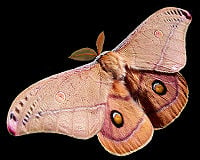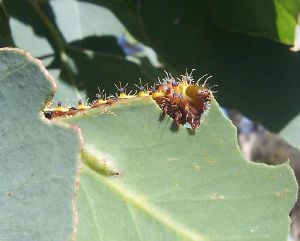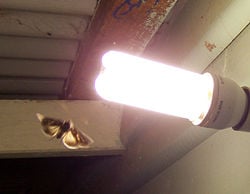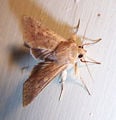Difference between revisions of "Moth" - New World Encyclopedia
Katya Swarts (talk | contribs) (Fixed taxobox) |
m ({{Contracted}}) |
||
| Line 1: | Line 1: | ||
| − | + | {{Contracted}} | |
{{Taxobox_begin | color=pink | name=Moths}} | {{Taxobox_begin | color=pink | name=Moths}} | ||
{{Taxobox_image | image = [[Image:Emperor Gum Moth.jpg|200px|]] | caption =[[Emperor Gum Moth]] }} | {{Taxobox_image | image = [[Image:Emperor Gum Moth.jpg|200px|]] | caption =[[Emperor Gum Moth]] }} | ||
Revision as of 18:33, 19 October 2006
| Moths | ||||||||
|---|---|---|---|---|---|---|---|---|
 Emperor Gum Moth | ||||||||
| Scientific classification | ||||||||
|
A moth is an insect closely related to the butterfly. Both are of the order Lepidoptera. The division of Lepidopterans into moths and butterflies is a popular taxonomy, not a scientific one. Sometimes the names "Rhopalocera" (butterflies) and "Heterocera" (moths) are used to formalise the popular distinction.
Most species of moths are nocturnal, but there are crepuscular and diurnal species. They can be distinguished from butterflies in several ways.
People who study butterflies and/or moths are called lepidopterists; the study of butterflies is known as butterflying, and the study of moths mothing, the latter giving rise to the term mother for someone who takes part in this activity – sometimes written with a hyphen inserted (moth-er) or as moffer to distinguish it from the word for a female parent (in spoken English, confusion does not arise as the two are pronounced differently).
Economic significance of moths

Moths, and more particularly their caterpillars, are a major agricultural pest in many parts of the world. The caterpillar of the Gypsy moth (Lymantria dispar) causes severe damage to forests in North East USA, where it is an exotic species. In temperate climates the Codling moth causes extensive damage, especially to fruit farms. In tropical and subtropical climates the diamondback moth (Plutella xylostella) is perhaps the most serious pest of brassicaceous crops.
Several moth species in the family Tineidae are commonly regarded as pests because their larvae eat fabric such as clothes and blankets made from natural proteinaceous fibers such as wool or silk. They are less likely to eat mixed materials containing artificial fibres. There are some reports that they can be repelled by the scent of wood from juniper and cedar, by lavender or by other natural oils. However, many consider this unlikely to prevent infestation. Naphthalene (the chemical used in mothballs) is considered more effective, but there are concerns over its effects on health. Moth larvae are not killed by freezing the items which they infest.
Moths are sturdy and usually are more resistant to pesticides than mosquitos and flies.
Some moths are farmed. Most notable is the silkworm (the larva of the domesticated moth Bombyx mori), farmed for the silk with which it builds its cocoon. The silk industry produces over 130 million kg of raw silk, worth about 250 million US dollars worldwide. Not all silk is produced by Bombyx mori. There are several species of Saturniidae that are also farmed for their silk, such as the Ailanthus moth (Samia cynthia group of species), the Chinese Oak Silkmoth (Antheraea pernyi), the Assam Silkmoth (Antheraea assamensis) and Japanese Silk Moth (Antheraea yamamai).
The mopane worm (the caterpillar of Gonimbrasia belina, from the family Saturniidae) is a significant food resource in southern Africa.
Attraction to light
Moths are apparently attracted to light, or more specifically, are known to circle bright objects. The reason for this behaviour is not known. It may be moths navigate by maintaining a constant angular relationship to a bright celestial light (such as the moon), but on encountering a bright artificial light it navigates by maintaining a constant angle to the light, resulting in the moth flying in a spiral until it hits the light source.
In 1972, Henry Hsiao, now professor of biomedical engineering, suggested that the reason for moths circling lights may have to do with a visual distortion called a Mach band [1]. Henry Hsiao conjectures that moths, as nocturnal creatures, fly towards the darkest part of the sky in pursuit of safety and are thus inclined to circle ambient objects in the Mach band region. This hypothesis is not scientifically accepted and has never been confirmed.
Night-blooming flowers usually depend on moths (or bats) for pollination, and artificial lighting can draw moths away from the flowers, affecting the plant's ability to reproduce. Light pollution is coming under increasing scrutiny as a source of many subtle ecological changes.
Moth species
Large and dramatic Moth species include:
- Death's-head Hawkmoth Acherontia sp.
- Luna Moth Actias luna
- Atlas moth Attacus atlas The largest moth in the world
- Emperor Gum Moth Opodiphthera eucalypti
- Polyphemus Moth Antheraea polyphemus
Moths that are of economic significance include:
- Gypsy moth Lymantria dispar
- Cotton bollworm or corn earworm Helicoverpa zea, a major agricultural pest
- Codling moth Cydia pomonella, a pest mostly of apple, pear and walnut trees
- Light brown apple moth Epiphyas postvittana
- The silkworm Bombyx mori is the larva of a moth.
Other notable moths:
- Peppered moth Biston betularia The subject of a now well known study in evolution.
See also
- Difference between a butterfly and a moth
- List of moths
Gallery
- LeopardMoth.jpg
Giant Leopard Moth (Arctiidae)
- Moth-Georgia-Oct12005.jpg
Grammia parthenice Tiger Moth (Arctiidae)
- Chelepteryx.collesi.02.jpg
Chelepteryx collesi (Gray) (Anthelidae)
External links
- Moths of North America - diagnostic large format photographs, taxonomy, descriptions
- North American Moth Photographers Group—web site with thousands of photographs (reproduced with permission there—check with individual photographers to reproduce)
- BugGuide—moths
- Life cycle photos of the salt marsh moth Estigmene acrea
- UK Moths
- UK Lepidoptera
- Butterflies and Moths of the Netherlands
- "European Butterflies" by Christopher Jonko : http://www.lepidoptera.bai.pl/start.php?lang=UK
ReferencesISBN links support NWE through referral fees
- ↑ Henry S. Hsiao, Attraction of moths to light and to infrared radiation. San Francisco Press (1972) ISBN 0911302212
Credits
New World Encyclopedia writers and editors rewrote and completed the Wikipedia article in accordance with New World Encyclopedia standards. This article abides by terms of the Creative Commons CC-by-sa 3.0 License (CC-by-sa), which may be used and disseminated with proper attribution. Credit is due under the terms of this license that can reference both the New World Encyclopedia contributors and the selfless volunteer contributors of the Wikimedia Foundation. To cite this article click here for a list of acceptable citing formats.The history of earlier contributions by wikipedians is accessible to researchers here:
The history of this article since it was imported to New World Encyclopedia:
Note: Some restrictions may apply to use of individual images which are separately licensed.










